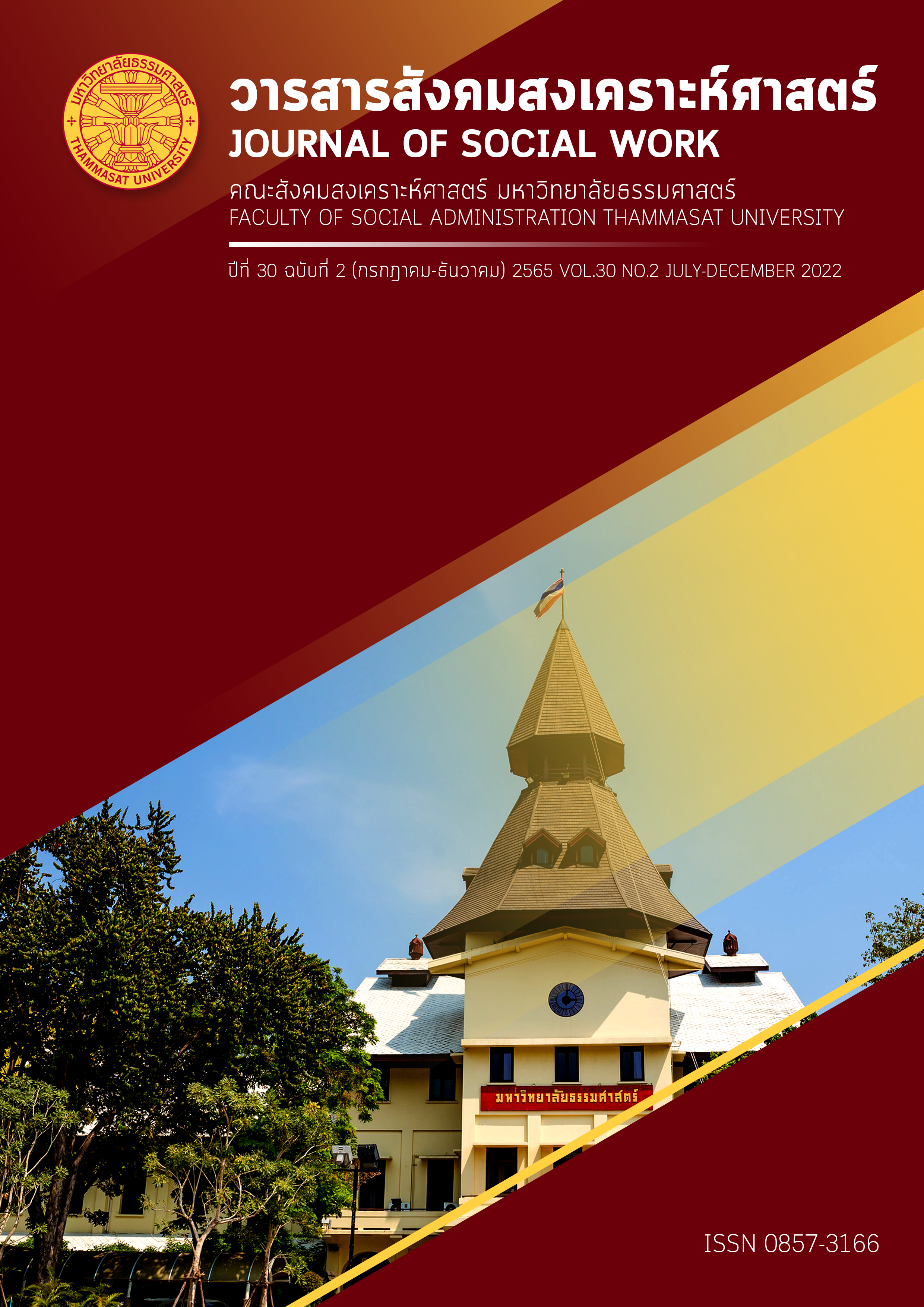The effect of Happiness-Building activities for medical social workers at Chulalongkorn
Keywords:
Medical social workers, Professional quality of life, Stress, Happiness of work life, Self-careAbstract
The study of the effect of Happiness-Building activities for medical social workers at Chulalongkorn Hospital aims to test the activities, compare score and study the factors used to predict the change in happiness, professional quality of life, and stress of medical social workers at Chulalongkorn Hospital during pre- mid- and post-experiments during January to June 2022. A total of 31 participants is medical social workers in Chulalongkorn Hospital. Demographic data, HAPPINOMETER, Professional Quality of life Scale (ProQOL-5), Suanprung Stress Test-20 (SPST-20), and 6-activity programs were applied. The Descriptive statistics were used to report the general characteristics of the participants, and inferential statistics, repeated measure ANOVA analysis of variance to test the difference within the group from baseline to after the program. Additionally, Multiple Linear Regression was used to find factors related to changes in happiness.
The study reveals that 1) Happiness-Building activities did not lead to a positive change in the happiness, professional quality of life and stress in pre – mid- and post-activity programs; 2) The results shows participants are still in ‘happy’ level in all 9 different dimension of happiness, gain moderate Professional quality of life and high-stress levels. Their scores are not significantly different scores at pre-activity test; 3) Each baseline is able to predict the dependent variables in a positive direction (p<0.001). Also, age, gender, hobby, and attending rate are able to predict the participants’ happiness, quality of life and stress (p<0.05). Males have tendency to be less happy in Social Happiness dimensions and more stress than females. Senior social workers experience less stress and secondary traumatic stress than junior social workers. Hobbies result in stress reduction from secondary traumatic stress and burnout. 4) Suggestions to increase happiness, quality of life for social workers and reduce stress is that the hospital should promote activities and training especially toward junior social workers. Activities may involve strategies to deal with stress or encourage the exchange of knowledge, advice a from senior social workers. The hospital should encourage social workers to have hobbies to reduce stress. Lastly, persons in charge or supervisors should provide advice and continue to promote services for good mental health.
References
งานโรคติดต่ออุบัติใหม่ กลุ่มพัฒนาวิชาการโรคติดต่อ. (2564). สถานการณ์โรคติดเชื้อโคโรนา 2019 (Covid-19) มาตรการสาธารณสุข และปัญหาอุปสรรคการป้องกันควบคุมโรคในผู้เดินทาง. สืบค้นจากhttp://ddc.moph.go.th/uploads/files/2017420210820025238.pdf
ชนิสรา ร่มเขื่อน. (2559). แนวทางการสร้างองค์กรสุขภาวะเมืองพัทยา. งานนิพนธ์ปริญญารัฐประศาสนศาสตรมหาบัณฑิต, มหาวิทยาลัยบูรพา ชลบุรี.
ณิชาภัทร วิบูลย์พานิช. (2545). วิธีการจัดการกับความเครียดของผู้ปฏิบัติงานกับเด็กและครอบครัว กองสงเคราะห์เด็กและบุคคลวัยรุ่น กรมประชาสงเคราะห์. สารนิพนธ์ปริญญาสังคมสงเคราะห์ศาสตรมหาบัณฑิต, มหาวิทยาลัยธรรมศาสตร์.
ดวงพร หน่อคำ. (2557). ความสัมพันธ์ระหว่างการรับรู้คุณค่าของงานกับความสุขในการทำงานของนักสังคมสงเคราะห์จิตเวช กรมสุขภาพจิต กระทรวงสาธารณสุข. วิทยานิพนธ์ปริญญาสังคมสงเคราะห์ศาสตรมหาบัณฑิต, มหาวิทยาลัยธรรมศาสตร์.
เทพวัลย์ สุชาติ. (2530). ปัจจัยที่สัมพันธ์กับความเครียดของนักสังคมสงเคราะห์ทางการแพทย์. วิทยานิพนธ์ปริญญาสังคมศาสตรมหาบัณฑิต, มหาวิทยาลัยมหิดล.
นงลักษณ์ เทพสวัสดิ์. (2555). ทฤษฎีและการปฏิบัติงานสังคมสงเคราะห์ (พิมพ์ครั้งที่ 2). กรุงเทพฯ: สำนักพิมพ์มหาวิทยาลัยธรรมศาสตร์.
นงลักษณ์ เอมประดิษฐ์. (2530). สังคมสงเคราะห์ทางการแพทย์ (พิมพ์ครั้งที่ 2). กรุงเทพฯ: มหาวิทยาลัยธรรมศาสตร์.
นพสิทธิ์ สิริจรูญชัย. (ม.ป.ป.). อนุภาคของการ"แสร้งทำ"เพื่อการดูแลตนเอง. สืบค้นจากhttps://chula.wellness.in.th/article/59
นัยนา แสงทอง. (2555). ความเครียดและความเหนื่อยหน่ายในงานของพยาบาลวิชาชีพ. วิทยานิพนธ์ปริญญาวิทยาศาสตรมหาบัณฑิต, มหาวิทยาลัยศิลปากร.
บุญธิดา บุญแก้ว. (2559). การปฏิบัติงานสังคมสงเคราะห์ของนักสังคมสงเคราะห์ทางการแพทย์ที่ได้รับใบอนุญาต. วิทยานิพนธ์ปริญญาสังคมสงเคราะห์ศาตรมหาบัณฑิต, มหาวิทยาลัยธรรมศาสตร์.
ประพัตรา จันธนะสมบัติ. (2545). ความชุกของความเครียดและปัจจัยที่เกี่ยวข้องกับความเครียดของแพทย์ประจำบ้าน โรงพยาบาลจุฬาลงกรณ์. วิทยานิพนธ์ปริญญาวิทยาศาสตรมหาบัณฑิต, จุฬาลงกรณ์มหาวิทยาลัย.
พงษ์เทพ สันติกุล. (2558). องค์การและการบริหารจัดการสวัสดิการสังคมและสังคมสงเคราะห์. กรุงเทพฯ: สำนักพิมพ์มหาวิทยาลัยธรรมศาสตร์.
มณิสา สุดิรัตน์. (2556). ความเครียดจากการทำงานของเจ้าหน้าที่ระดับปฏิบัติงานศูนย์การจัดสวัสดิการและสังคมผู้สูงอายุบ้านบางแค. วารสารมหาวิทยาลัยราชภัฏลำปาง, 1(2), 17-26. สืบค้นจาก https://so04.tci-thaijo.org/index.php/JLPRU/article/view/24624/20946.
ระพีพรรณ คำหอม. (2556). หลักการและกระบวนการปฏิบัติงานสังคมสงเคราะห์จุลภาค (พิมพ์ครั้งที่ 2). กรุงเทพฯ: สำนักพิมพ์มหาวิทยาลัยธรรมศาสตร์.
โรงพยาบาลจุฬาลงกรณ์ สภากาชาดไทย. (2563). ประกาศ-ประชาสัมพันธ์โรงพยาบาลจุฬาลงกรณ์. สืบค้นจาก http://chulalongkornhospital.go.th/kcmh/chula-covid-19/anouncecovid/
โรงพยาบาลจุฬาลงกรณ์ สภากาชาดไทย. (ม.ป.ป.). ฝ่ายสวัสดิการสังคม (Social Welfare). สืบค้นจากhttps://chulalongkornhospital.go.th/kcmh/dept/ฝ่ายสวัสดิการสังคม/
วันทนีย์ วาสิกะสิน, สุรางรัตน์ วศินารมณ์ และ กิติพัฒน์ นนทปัทมะดุลย์. (2553). ความรู้ทั่วไปเกี่ยวกับสวัสดิการสังคมและสังคมสงเคราะห์ (พิมพ์ครั้งที่ 7). กรุงเทพฯ: สำนักพิมพ์มหาวิทยาลัยธรรมศาสตร์.
วาสนา จึงตระกูล. (2562). การประเมินความสุขของบุคลากรโรงพยาบาลสงขลา ประจําปี 2562. วารสารมนุษยศาสตร์และสังคมศาสตร์ มหาวิทยาลัยราชภัฏสงขลา, 2(2), 106-132.
ศศิวิมล ปานุราช. (2560). ปัจจัยที่มีความสัมพันธ์กับพฤติกรรมการดูแลแบบเอื้ออาทรของพยาบาลในการดูแลผู้ป่วยระยะสุดท้าย (วิทยานิพนธ์ปริญญาพยาบาลศาสตรมหาบัณฑิต). มหาวิทยาลัยธรรมศาสตร์
ศิรินันท์ กิตติสุขสถิต, เฉลิมพล แจ่มจันทร์, กาญจนา ตั้งชลทิพย์ และจรัมพร โห้ลำยอง. (2556). คุณภาพชีวิต การทำงาน และความสุข. กรุงเทพฯ: โรงพิมพ์ธรรมดาเพรสจำกัด.
ศิริลักษณ์ เตชะธนอิทธิกุล. (2561). ความเครียด ความเหนื่อยล้าในการเห็นอกเห็นใจ ความพึงพอใจในการเห็นอกเห็นใจและสุขภาวะของนักวิชาชีพผู้ให้บริการด้านสุขภาพจิต. วิทยานิพนธ์ปริญญาศิลปศาสตรมหาบัณฑิต, จุฬาลงกรณ์มหาวิทยาลัย.
ศุภาพิชญ์ (มณีสาคร) โฟน โบร์แมนน์, วรรณวิไล ภู่ตระกูล, และนิรนาท วิทยโชคกิติคุณ. (2556). “โปรดดูแลเราก่อนที่พวกเราจะลาออก” สถานการณ์กำลังคนด้านสุขภาพจิตและจิตเวชที่ปฏิบัติงานนอกสังกัดกรมสุขภาพจิต กระทรวงสาธารณสุข. วารสารวิจัยทางวิทยาศาสตร์สุขภาพ, 7(2), 37-46.
สถาบันกัลยาณ์ราชนครินทร์ สำนักสุขภาพจิต. (2555). คู่มือคลายเครียด (ฉบับปรับปรุงใหม่). สืบค้นจาก https://www.dmh.go.th/ebook/view.aspid=345
สภาวิชาชีพสังคมสงเคราะห์. (2564). สถิติจำนวนผู้ขึ้นทะเบียนรับอนุญาตและจำนวนสมาชิกสามัญ ประจำปี 2563. สืบค้นจาก https://www.docs.google.com/spreadsheets/u/0/d/116mDz3A-y8-rBghtuGnhJg YcU7v7Qyea68Bx_Xm_bhg/htmlview#
สำนักงานกองทุนสนับสนุนสุขภาวะองค์กร. (ม.ป.ป.). Happy Workplace. สืบค้นจาก https://happy8workplace.thaihealth.or.th/about/what-is-it
สำนักงานราชบัณฑิตยสภา. (ม.ป.ป). พจนานุกรม ฉบับบัณฑิตราชยบัณฑิตยสถาน พ.ศ.2554. สืบค้นจาก https://dictionary.orst.go.th/
สุนิสา สุขสงเคราะห์. (2562). ปัจจัยที่มีผลต่อการทำงานอย่างมีความสุขของนักสังคมสงเคราะห์องค์กรปกครองส่วนท้องถิ่น [วิทยานิพนธ์ปริญญาสังคมสงเคราะห์ศาสตรมหาบัณฑิต, มหาวิทยาลัยธรรมศาสตร์].
สุภัทรา เผือกโสดา. (2556). การศึกษาความสัมพันธ์ระหว่างปัจจัยส่วนบุคคลกับความสุขในการทำงาน กรณีศึกษา อาจารย์และเจ้าหน้าที่มหาวิทยาลัยหอการค้าไทย, มหาวิทยาลัยหอการค้าไทย.
สุภาวดี พรสิบ. (2545). การปฏิบัติงานสังคมสงเคราะห์ทางการแพทย์สู่ระบบคุณภาพงานบริการ ในทัศนะของนักสังคมสงเคราะห์ทางการแพทย์. วิทยานิพนธ์ปริญญาสังคมสงเคราะห์ศาสตรมหาบัณฑิต, มหาวิทยาลัยธรรมศาสตร์.
สุรชัย แก้วพิกุล. (2552). คุณภาพชีวิตในการทำงานของบุคลากรวิทยาลัยพยาบาลตำรวจ. วิทยานิพนธ์ปริญญาสังคมสงเคราะห์ศาสตรมหาบัณฑิต, มหาวิทยาลัยธรรมศาสตร์.
สุวรรณี สุวรรณไพบูลย์. (2559). ทัศนะของบุคลากรกรมพัฒนาสังคมและสวัสดิการต่อการเป็นองค์กรสร้างสุข. วิทยานิพนธ์ปริญญาสังคมสงเคราะห์ศาสตรมหาบัณฑิต, มหาวิทยาลัยธรรมศาสตร์.
สุวัฒน์ มหัตนิรันดร์กุล, วนิดา พุ่มไพศาลชัย, และพิมพ์มาศ ตาปัญญา. (2540). การสร้างแบบวัดความเครียดสวนปรุง. วารสารสวนปรุง, 13(3), 1-20. https://suicide.dmh.go.th/abstract/details.asp?id=2404
หฤทัย จงไกรจักร. (2553). สุขภาพจิต การดูแลตนเอง และความท้อแท้ในการปฏิบัติงานของบุคลากรทางการแพทย์โรงพยาบาลศูนย์การแพทย์ สมเด็จพระเทพรัตนราชสุดาฯ สยามบรมราชกุมารี. มหาวิทยาลัยรามคำแหง.
อาริยา ก้อนเมฆ. (2552). การปฏิบัติงานของนักสังคมสงเคราะห์ศูนย์บริการสาธารณสุข สำนักอนามัยกรุงเทพมหานครภายใต้สมรรถนะหลัก กรุงเทพมหานคร. วิทยานิพนธ์ปริญญาสังคมสงเคราะห์ศาสตรมหาบัณฑิต, มหาวิทยาลัยธรรมศาสตร์.
Chayu T., Kreitler S. (2011). Burnout in nephrology nurses in Israel. Nephrology Nursing Journal. 38(1), 65-78.
Christie A. (2006). Negotiating the uncomfortable intersections between gender and professional identities in social work. Critical Social Policy, 26(2), 390-411.
Collings JA, Murray P. (1996). Predictors of stress amongst social workers: An empirical study. The British Journal of Social Work, 26(3), 375-387.
Friganovic A., Selic P., & Ilic B. (2019). Stress and burnout syndrome and their associations with coping and job satisfaction in critical care nurses: A literature review. Psychiatria Danubina, 31(Suppl 1), 21–31.
Jayaratne S, Tripodi T, & Chess WA. (1983). Perceptions of emotional support, stress, and strain by male and female social workers. Social Work Research and Abstracts., 19(2), 19-27.
Pressman SD, Matthews KA, Cohen S, Martire LM, Scheier M, Baum A, et al. (2009). Association of enjoyable leisure activities with psychological and physical well-being. Psychosomatic medicine. 71(7), 725-732.
Regehr C. (2018). Stress, Trauma, and Decision-Making for Social Workers. Columbia University Press.
Simpson R. (2004). Masculinity at work: The experiences of men in female dominated occupations. Work, employment and society, 18(2), 349-368.
Stamm, B. H. (2010). The Concise ProQOL Manual (2 ed.). ocatello, ID: ProQOL.org.
University at Buffalo: School of Social work. (n.d.). Introduction to Self-Care. https://socialwork.buffalo.edu/resources/self-care-starter-kit/introduction-to-self-care.html
Xu Y, Harmon-Darrow C, Frey JJ. (2019). Rethinking professional quality of life for social workers: Inclusion of ecological self-care barriers. Journal of Human Behavior in the Social Environment, 29(1), 11-25.
Youngs D.E., Yaneva M.A., Canter D.V. (2021). Development of a measure of kindness. Current Psychology, (2021), 1-13.
Downloads
Published
How to Cite
Issue
Section
License
Copyright (c) 2022 Journal of Social Work

This work is licensed under a Creative Commons Attribution-NonCommercial-NoDerivatives 4.0 International License.
The manuscripts published in the Social Work Journal is the copyright of the Social Work Journal, Thammasat University
Any article or opinion appeared in the Social Work Journal will solely be under the responsibility of the author The Faculty of Social Administration, Thammasat University and the editors do not need to reach in agreement or hold any responsibility.



